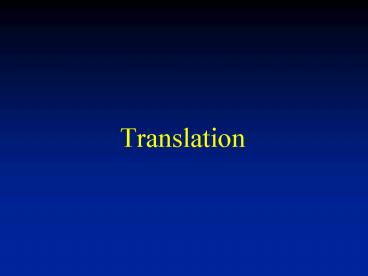Translation PowerPoint PPT Presentation
1 / 25
Title: Translation
1
Translation
2
Translation
- Translation- the synthesis of protein from an RNA
template. - Five stages Preinitiation
- Initiation
- Elongation
- Termination
- Post-translational modification
- Complicated In eukaryotes, 300 molecules
involved
3
Functions of the Types of RNA
- mRNA- serves as a template code
- tRNA- serves as an adapter molecule
- rRNA- holds molecules in the correct position,
protein portion also catalyze reactions
4
tRNA Structure
- All tRNA molecules have a similar but not
identical structure- cloverleaf - Acceptor arm- CCA-3
- an amino acid will be esterified to 3 OH of A
- TYC arm
- named for ribothymidine-pseudouridine-cytidine
sequence - Extra arm
- variable in size 3-20 nt
5
tRNA Structure, contd
- anti-codon arm
- named for 3 bases which base-pair with mRNA
codon - D arm-
- dihydrouridine base modification
- Sequence differs for the different amino acid-
not just in the anticodon arm
6
mRNA Structure
- Shine-Dalgarno sequence
- 10 nt upstream of initiation codon
- Positions ribosome at correct start site
7
The Genetic Code
- Triplet codons
- Universal (almost)
- Commaless
- Degenerate- wobble
- Unambiguous
- Reading frames
- Embedded genes
8
Preinitiation - Charging the tRNA
9
Aminoacyl-tRNA Synthetase
- One for each amino acid
- 2 step mechanism
- attach a.a. to AMP
- transesterify to 3 (or 2 and then rearrange)
- Proofread
- identity elements
- sieve
- Modify Met-tRNAfmet to fMet-tRNAfmet
10
Preinitiation
- 1. Charging the tRNA
- 2. Formylation of met-tRNAfmet
11
Preinitiation
- 1. Charging the tRNA
- 2. Formylation of met-tRNAfmet
- 3. Dissociation of ribosomes (IF-1 and IF-3)
- 4. IF-2GTP binary complex formation
- 5. IF-2GTPcharged tRNA ternary complex
formation - 6. IF4F, 4A and 4B bind mRNA to place it on
small subunit - 7. 40S initiation complex
12
Initiation
- Preinitiation complexes form an 80S complex
- small subunit, ternary complex (GDP Pi leave),
mRNA, large subunit, aminoacyl tRNA - P-site- only thing that can enter is a peptide
- In prokaryotes, f-met tricks the ribosome
- A-site- only thing that can enter is an aminoacyl
tRNA
13
Elongation
- 1. EF-1GTPaminoacyl-tRNA ternary complex
enters A-site GDP Pi leave - (EF-Tu and EF-Ts involved with GTP metabolism in
prokaryotes) - 2. Peptide bond forms as P-site content is
transferred onto A-site occupant - 3. Translocation requires GTP GDP Pi are
products
14
Termination
- 1. UAA, UAG, UGA is enveloped by A-site of
ribosome - 2. RF-1 enters A site
- 3. GTP is hydrolyzed, H2O is used to cleave
protein off tRNA - 4. Components are recycled to synthesize another
protein molecule
15
Energetics
- Each amino acid residue requires 4 ATP
equivalents - ATP AMP PPi to charge tRNA
- 1 GTP is used to place aminoacyl-tRNA into
A-site - 1 GTP is used to translocate after each peptide
bond formation
16
Regulation of Translation
- 1. Elongation factor 2-
- a. phosphorylated under stress
- b. when phosphorylated, doesnt allow GDP- GTP
exchange and protein synthesis stops - 2. eIF-4E/4E-BP complex can be phosphorylated
17
Post-translational Modifications
- 1. Proteolytic cleavage (most common)
- a. Direction into the ER and signal sequence
cleavage - b. Other signal sequences exist for other
organelles - c. Activation
- 2. Disulfide bond formation
18
Post-translational Modifications, contd.
- 3. Group addition
- a. Glycosylation (most complex known)
- b. Acetylation or phosphorylation, etc.
- 4. Amino acid modification
- a. Hydroxylation of Pro (in ER)
- b. Methylation of Lys
- This list is not exhaustive
19
Genetic RegulationConstitutive vs. Inducible
Expression
- Constitutive- A gene is expressed at the same
level at all times. AKA housekeeping gene. - Inducible- A gene is expressed at higher level
under the influence of some signal.
20
Genetic Regulation - The Operon
- Operon- an operator plus two or more genes under
control of that operator - Occurs only in prokaryotes (in eukaryotes, each
gene is under separate control). - Best known is the lac operon of Jacob and Monod
21
The Operon Under Normal Expression
22
The Operon Under Induced Expression
23
Eukaryotic Transcriptional Regulation
- TATA box- where to start
- CAAT box and Enhancer- how often to start
24
Post-Transcriptional Regulation
- 1. mRNA stability can be altered by signal
molecules - PEPCK
- Insulin 30 min
- -Insulin 3 h
25
Mutations
- Mutation- change in DNA sequence leading to a
different protein sequence being produced - -same codon produced
- Missense- different codon introduced
- Silent (acceptable)
- Partially acceptable
- Nonsense-stop codon introduced
- Usually unacceptable

